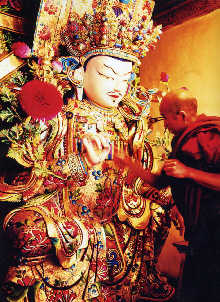Along theYellow Riverdown to the southeast ofQinghai Province,TongrenCounty has been familiarized as the "home of Regong art". With a history of more than 700 years, this unique Tibetan cultural legacy is called "the flower on the Tibetan Plateau" and "a magnificent pearl of Chinese art". Almost every man here inherits the art as his occupation, and almost every man here is an artisan.
 The golden valley: cradle of artists
The golden valley: cradle of artists
 Lying in the southeast of Qinghai Province in Northwest China, Tongren County is the center of Huangnan Tibetan Autonomous Prefecture, 188 kilometers south of the provincial capital Xining.
Lying in the southeast of Qinghai Province in Northwest China, Tongren County is the center of Huangnan Tibetan Autonomous Prefecture, 188 kilometers south of the provincial capital Xining.
Regong, which means "golden valley", is the Tibetan name of Tongren. In the 15-16 century, the TibetanBuddhismof Gelukpa Sect (Yellow Sect) came to Tongren area, where the Regong art sprang up along with the rise of Tibetan Buddhism and the construction of monasteries. By the mid-17th century, Regong (Tongren) had become a village where nearly everyone could paint and every family was engaged in the art.
Tongren has under its jurisdiction two towns, ten villages and 75 hamlets. The five villages nearby Longwu Town are known as the "birthplaces of Regong art", namely Wutun, Nianduhu, Gasairi, Guomari, and Tuojia, each with a monastery except Wutun, which has two. Tongren together with its villages has become a hotspot for travelers who swarm into Qinghai for the mysterious Tibetan cultural legacies.
In the small Tongren area, the Red Sect monasteries and the Yellow Sect monasteries are everywhere. Quite a number of monasteries are built in the Ming (1368-1644) and Qing (1644-1911) dynasties. The complex here is a typically Tibetan group of pagoda-roof ed monastic buildings among many more prosaic flat-topped dwellings for the monks, all within a walled compound scattered up a hillside.
Almost every village has its own monasteries that are the Buddhist centers as well as the cradle of artists. Children here, influenced by Regong artists, will go to the monasteries when they grow a little older to learn the art. When they are 15 years old, they have to make their choice, either to resume secular life or to become lifetime monk. It's this open and free atmosphere that makes the Regong art popularized and develop continuously.
